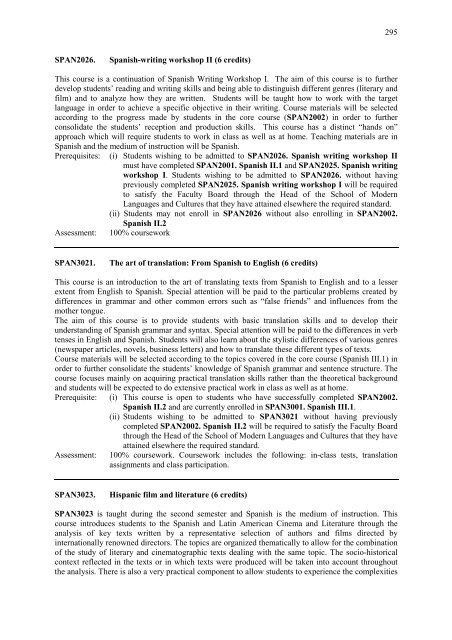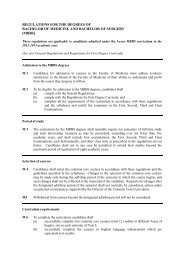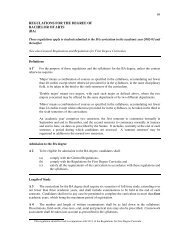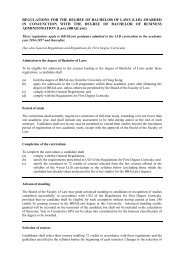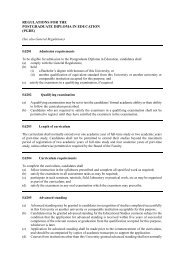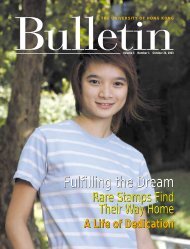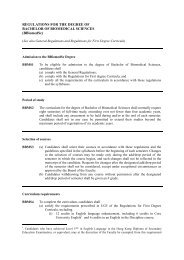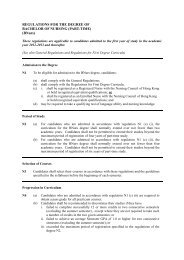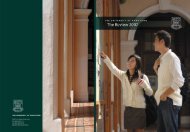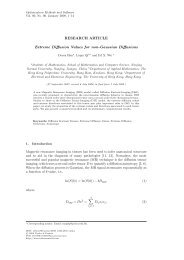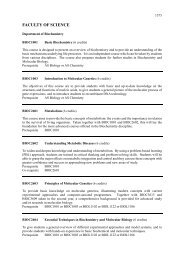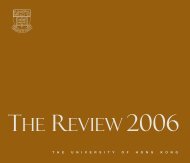(BA) (4-year-programme) - The University of Hong Kong
(BA) (4-year-programme) - The University of Hong Kong
(BA) (4-year-programme) - The University of Hong Kong
Create successful ePaper yourself
Turn your PDF publications into a flip-book with our unique Google optimized e-Paper software.
295SPAN2026.Spanish-writing workshop II (6 credits)This course is a continuation <strong>of</strong> Spanish Writing Workshop I. <strong>The</strong> aim <strong>of</strong> this course is to furtherdevelop students’ reading and writing skills and being able to distinguish different genres (literary andfilm) and to analyze how they are written. Students will be taught how to work with the targetlanguage in order to achieve a specific objective in their writing. Course materials will be selectedaccording to the progress made by students in the core course (SPAN2002) in order to furtherconsolidate the students’ reception and production skills. This course has a distinct “hands on”approach which will require students to work in class as well as at home. Teaching materials are inSpanish and the medium <strong>of</strong> instruction will be Spanish.Prerequisites: (i) Students wishing to be admitted to SPAN2026. Spanish writing workshop IImust have completed SPAN2001. Spanish II.1 and SPAN2025. Spanish writingworkshop I. Students wishing to be admitted to SPAN2026. without havingpreviously completed SPAN2025. Spanish writing workshop I will be requiredto satisfy the Faculty Board through the Head <strong>of</strong> the School <strong>of</strong> ModernLanguages and Cultures that they have attained elsewhere the required standard.(ii) Students may not enroll in SPAN2026 without also enrolling in SPAN2002.Spanish II.2Assessment: 100% courseworkSPAN3021.<strong>The</strong> art <strong>of</strong> translation: From Spanish to English (6 credits)This course is an introduction to the art <strong>of</strong> translating texts from Spanish to English and to a lesserextent from English to Spanish. Special attention will be paid to the particular problems created bydifferences in grammar and other common errors such as “false friends” and influences from themother tongue.<strong>The</strong> aim <strong>of</strong> this course is to provide students with basic translation skills and to develop theirunderstanding <strong>of</strong> Spanish grammar and syntax. Special attention will be paid to the differences in verbtenses in English and Spanish. Students will also learn about the stylistic differences <strong>of</strong> various genres(newspaper articles, novels, business letters) and how to translate these different types <strong>of</strong> texts.Course materials will be selected according to the topics covered in the core course (Spanish III.1) inorder to further consolidate the students’ knowledge <strong>of</strong> Spanish grammar and sentence structure. <strong>The</strong>course focuses mainly on acquiring practical translation skills rather than the theoretical backgroundand students will be expected to do extensive practical work in class as well as at home.Prerequisite: (i) This course is open to students who have successfully completed SPAN2002.Spanish II.2 and are currently enrolled in SPAN3001. Spanish III.1.(ii) Students wishing to be admitted to SPAN3021 without having previouslycompleted SPAN2002. Spanish II.2 will be required to satisfy the Faculty Boardthrough the Head <strong>of</strong> the School <strong>of</strong> Modern Languages and Cultures that they haveattained elsewhere the required standard.Assessment: 100% coursework. Coursework includes the following: in-class tests, translationassignments and class participation.SPAN3023.Hispanic film and literature (6 credits)SPAN3023 is taught during the second semester and Spanish is the medium <strong>of</strong> instruction. Thiscourse introduces students to the Spanish and Latin American Cinema and Literature through theanalysis <strong>of</strong> key texts written by a representative selection <strong>of</strong> authors and films directed byinternationally renowned directors. <strong>The</strong> topics are organized thematically to allow for the combination<strong>of</strong> the study <strong>of</strong> literary and cinematographic texts dealing with the same topic. <strong>The</strong> socio-historicalcontext reflected in the texts or in which texts were produced will be taken into account throughoutthe analysis. <strong>The</strong>re is also a very practical component to allow students to experience the complexities


